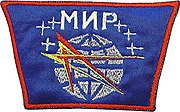| COSPAR ID | 1987-013A |
|---|---|
| SATCAT no. | 17482 |
| Mission duration | 174 days, 3 hours, 25 minutes, 56 seconds |
| Orbits completed | ~2,810 |
| Spacecraft properties | |
| Spacecraft | Soyuz 7K-STM No. 52 |
| Spacecraft type | Soyuz-TM |
| Manufacturer | NPO Energia |
| Launch mass | 7,100 kilograms (15,700 lb) |
| Crew | |
| Crew size | 2 up 3 down |
| Members | Aleksandr Laveykin |
| Launching | Yuri Romanenko |
| Landing | Aleksandr Viktorenko Muhammed Faris |
| Callsign | Taimyr |
| Start of mission | |
| Launch date | 5 February 1987, 21:38:16 UTC[1] |
| Rocket | Soyuz-U2 |
| Launch site | Baikonur 1/5 |
| End of mission | |
| Landing date | 30 July 1987, 01:04:12 UTC[2] |
| Landing site | 80 kilometres (50 mi) from Arkalyk |
| Orbital parameters | |
| Reference system | Geocentric |
| Regime | Low Earth |
| Perigee altitude | 341 kilometres (212 mi) |
| Apogee altitude | 365 kilometres (227 mi) |
| Inclination | 51.6 degrees |
| Period | 91.6 minutes |
| Docking with Mir[3] | |
| Docking date | 7 February 1987, 23:27:40 UTC |
| Undocking date | 29 July 1987, 20:44:00 UTC |

Soyuz programme (Crewed missions) | |
Soyuz TM-2 was a crewed spaceflight to the Soviet space station Mir, which was uncrewed at the time. TM-2 was launched on February 5, 1987, and it was first crewed spaceflight of the Soyuz-TM spacecraft,[4] and the second crewed spaceflight to Mir (the first being Soyuz T-15). The crew of the long duration expedition, Mir EO-2, who were launched by TM-2 consisted of Soviet cosmonauts Yuri Romanenko and Aleksandr Laveykin.
The spacecraft remained docked to Mir, functioning as a lifeboat for the EO-2 crew, until July 1987 when it returned to Earth carrying Laveykin and the two man crew of Mir EP-1. Romanenko later returned to Earth in Soyuz TM-3 at the end of EO-2.
Crew
[edit]| Position | Launching crew | Landing crew |
|---|---|---|
| Commander | Mir EO-2 Third and last spaceflight |
Mir EP-1 First spaceflight |
| Flight Engineer | Mir EO-2 Only spaceflight | |
| Research Cosmonaut | None | Mir EP-1 Only spaceflight |
Mission parameters
[edit]- Mass: 7100 kg
- Perigee: 341 km
- Apogee: 365 km
- Inclination: 51.6°
- Period: 91.6 minutes
Mission highlights
[edit]Early in the expedition EO-2, the module Kvant-1 was launched to automatically dock with Mir. The docking system, known as the "Igla system", was not behaving as expected. On April 5 the EO-2 crew retreated to the Soyuz TM-2 spacecraft so that they could escape in the event the module got out of control. About 200 m out, the docking system lost its lock on Mir's aft port antenna. The cosmonauts watched from within Soyuz TM-2 as the Kvant/ FSM combination passed within 10 m of the station.[1] Following an emergency spacewalk, Kvant fully docked to the station on April 11.
References
[edit]- ^ a b "Mir EO-2". Encyclopedia Astronautica. Archived from the original on 9 April 2007. Retrieved 11 November 2010.
- ^ "Mir EP-1". Encyclopedia Astronautica. Archived from the original on 29 November 2010. Retrieved 11 November 2010.
- ^ "Soyuz TM-2". Spacefacts.de. Retrieved 21 March 2021.
- ^ "Soyuz TM". Encyclopedia Astronautica. Archived from the original on June 24, 2002. Retrieved 11 November 2010.


Well, that’s interesting to know that Psilotum nudum are known as whisk ferns. Psilotum nudum is the commoner species of the two. While the P. flaccidum is a rare species and is found in the tropical islands. Both the species are usually epiphytic in habit and grow upon tree ferns. These species may also be terrestrial and grow in humus or in the crevices of the rocks.
View the detailed Guide of Psilotum nudum: Detailed Study Of Psilotum Nudum (Whisk Fern), Classification, Anatomy, Reproduction